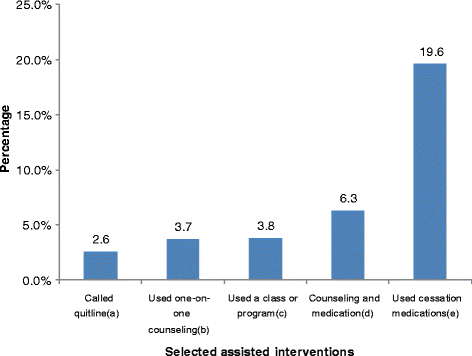Receipt of evidence-based brief cessation interventions by health professionals and use of cessation assisted treatments among current adult cigarette-only smokers: National Adult Tobacco Survey, 2009-2010
- PMID: 26868930
- PMCID: PMC4751655
- DOI: 10.1186/s12889-016-2798-2
Receipt of evidence-based brief cessation interventions by health professionals and use of cessation assisted treatments among current adult cigarette-only smokers: National Adult Tobacco Survey, 2009-2010
Abstract
Background: Helping tobacco smokers to quit during a medical visit is a clinical and public health priority. Research suggests that most health professionals engage their patients in at least some of the '5 A's' of the brief cessation intervention recommended in the U.S. Public Health Service Clinical Practice Guideline, but information on the extent to which patients act on this intervention is uncertain. We assessed current cigarette-only smokers' self-reported receipt of the 5 A's to determine the odds of using optimal cessation assisted treatments (a combination of counseling and medication).
Methods: Data came from the 2009-2010 National Adult Tobacco Survey (NATS), a nationally representative landline and mobile phone survey of adults aged ≥18 years. Among current cigarette-only smokers who visited a health professional in the past 12 months, we assessed patients' self-reported receipt of the 5 A's, use of the combination of counseling and medication for smoking cessation, and use of other cessation treatments. We used logistic regression to examine whether receipt of the 5 A's during a recent clinic visit was associated with use of cessation treatments (counseling, medication, or a combination of counseling and medication) among current cigarette-only smokers.
Results: In this large sample (N = 10,801) of current cigarette-only smokers who visited a health professional in the past 12 months, 6.3 % reported use of both counseling and medication for smoking cessation within the past year. Other assisted cessation treatments used to quit were: medication (19.6 %); class or program (3.8 %); one-on-one counseling (3.7 %); and telephone quitline (2.6 %). Current cigarette-only smokers who reported receiving all 5 A's during a recent clinic visit were more likely to use counseling (odds ratio [OR]: 11.2, 95 % confidence interval [CI]: 7.1-17.5), medication (OR: 6.2, 95 % CI: 4.3-9.0), or a combination of counseling and medication (OR: 14.6, 95 % CI: 9.3-23.0), compared to smokers who received one or none of the 5 A's components.
Conclusions: Receipt of the '5 A's' intervention was associated with a significant increase in patients' use of recommended counseling and medication for cessation. It is important for health professionals to deliver all 5 A's when conducting brief cessation interventions with patients who smoke.
Figures
References
-
- U.S. Department of Health and Human Services . The Health Consequences of Smoking-50 Years of Progress: A Report of the Surgeon General. Atlanta: U.S. Department of Health and Human Services, Centers for Disease Control and Prevention, National Center for Chronic Disease Prevention and Health Promotion, Office on Smoking and Health; 2014.
-
- Fiore MC, Bailey WC, Cohen SJ, Dorfman SF, Goldstein MG, Gritz ER, et al. Treating Tobacco Use and Dependence: 2008 Update—Clinical Practice Guideline. Rockville: U.S. Department of Health and Human Services, Public Health Service, Agency for Healthcare Research and Quality; 2008.
MeSH terms
LinkOut - more resources
Full Text Sources
Other Literature Sources
Medical
Miscellaneous



